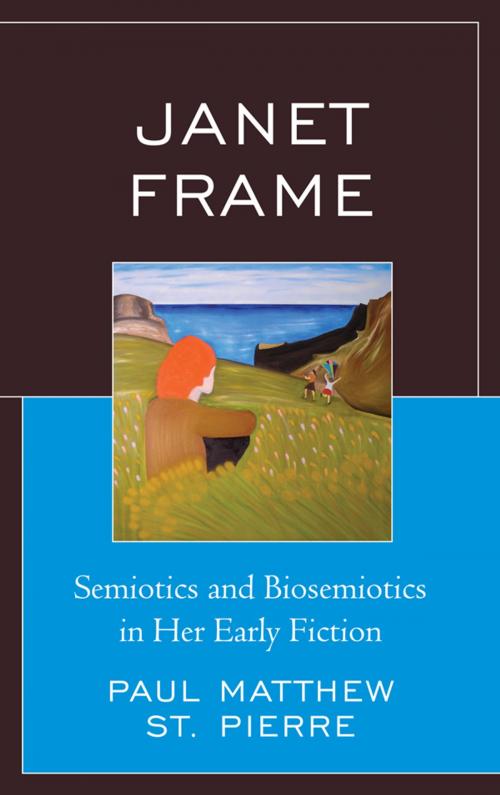Janet Frame
Semiotics and Biosemiotics in Her Early Fiction
Fiction & Literature, Literary Theory & Criticism, Women Authors, Theory| Author: | Matthew Paul St. Pierre | ISBN: | 9781611470512 |
| Publisher: | Fairleigh Dickinson University Press | Publication: | May 12, 2011 |
| Imprint: | Fairleigh Dickinson University Press | Language: | English |
| Author: | Matthew Paul St. Pierre |
| ISBN: | 9781611470512 |
| Publisher: | Fairleigh Dickinson University Press |
| Publication: | May 12, 2011 |
| Imprint: | Fairleigh Dickinson University Press |
| Language: | English |
In Janet Frame: Semiotics and Biosemiotics in Her Early Fiction, Paul Matthew St. Pierre exploits the linguistic discipline of semiotics and the neurobiological discipline of biosemiotics to propose an original and dynamic reading of the first four works of fiction by New Zealand writer Janet Frame (1924-2004): The Lagoon: Stories (1951), Owls Do Cry (1957), Faces in the Water (1961), and The Edge of the Alphabet (1962). Opposing the prevailing reading of Frame's early fiction as autobiographical, deriving from her medical history, he argues her books are singular evocations of her astonishing imagination. His purpose is to fix this historical record and provide an alternative model for interpreting one of the 20th century's most stylistically demanding and rewarding writers. Semiotics and biosemiotics are his means for unlocking the early fiction and her later works to a polemical analysis focusing on language, sign transmissions, writing the body, and the biosemiotic self. In The Lagoon, Owls Do Cry, Faces in the Water, and The Edge of the Alphabet Frame produced what St. Pierre interprets as an original semiotic and biosemiotic modeling system that she applied throughout her oeuvre of twenty books, comprising eight story collections, seven novels, a book of poetry, a children's novel, and three volumes of autobiography. Using this modeling system, she designed her fiction as a visual verbal field consisting of still and moving images generated in the imagination, located in the brains and central nervous systems of her narrators, characters, and readers, and, primarily, of the author herself. The author discusses the significations of: 1) Frame's image-signs in water, glass, photographs, film, membranes, skin, and clothing; 2) her primary sign repertoire of objects, language, and human persons in the figures of blood, skin, and sun; 3) her body-signs, including those generated in the circulatory and neurological systems of all human organisms as biosemiotic living systems, in facial displays and body parts such as teeth, temples, eyes, skin, hair, nostrils, shoulders, knees, cheeks, vaginas, and prefrontal lobes; 4) her theories of the body, normalcy, and selfhood in the figures of urine, feces, blood, sweat, bile, saliva, phlegm, and semen, and body parts such as feet, hands, noses, teeth, lips, entrails, and wombs, in the context of social forces of dismemberment; 5) her biosemiotic system applied to her subsequent books, constituting her theory of human beings as sign-transmitting organisms, living systems doubled with and interchangeable with the closed sign system of her oeuvre. Janet Frame: Semiotics and Biosemiotics in Her Early Fiction is designed to appeal to the international audience of Frame readers and a specialized audience of semioticians and biosemioticians who investigate how sign transmissions function in visual verbal fields and related living systems.
In Janet Frame: Semiotics and Biosemiotics in Her Early Fiction, Paul Matthew St. Pierre exploits the linguistic discipline of semiotics and the neurobiological discipline of biosemiotics to propose an original and dynamic reading of the first four works of fiction by New Zealand writer Janet Frame (1924-2004): The Lagoon: Stories (1951), Owls Do Cry (1957), Faces in the Water (1961), and The Edge of the Alphabet (1962). Opposing the prevailing reading of Frame's early fiction as autobiographical, deriving from her medical history, he argues her books are singular evocations of her astonishing imagination. His purpose is to fix this historical record and provide an alternative model for interpreting one of the 20th century's most stylistically demanding and rewarding writers. Semiotics and biosemiotics are his means for unlocking the early fiction and her later works to a polemical analysis focusing on language, sign transmissions, writing the body, and the biosemiotic self. In The Lagoon, Owls Do Cry, Faces in the Water, and The Edge of the Alphabet Frame produced what St. Pierre interprets as an original semiotic and biosemiotic modeling system that she applied throughout her oeuvre of twenty books, comprising eight story collections, seven novels, a book of poetry, a children's novel, and three volumes of autobiography. Using this modeling system, she designed her fiction as a visual verbal field consisting of still and moving images generated in the imagination, located in the brains and central nervous systems of her narrators, characters, and readers, and, primarily, of the author herself. The author discusses the significations of: 1) Frame's image-signs in water, glass, photographs, film, membranes, skin, and clothing; 2) her primary sign repertoire of objects, language, and human persons in the figures of blood, skin, and sun; 3) her body-signs, including those generated in the circulatory and neurological systems of all human organisms as biosemiotic living systems, in facial displays and body parts such as teeth, temples, eyes, skin, hair, nostrils, shoulders, knees, cheeks, vaginas, and prefrontal lobes; 4) her theories of the body, normalcy, and selfhood in the figures of urine, feces, blood, sweat, bile, saliva, phlegm, and semen, and body parts such as feet, hands, noses, teeth, lips, entrails, and wombs, in the context of social forces of dismemberment; 5) her biosemiotic system applied to her subsequent books, constituting her theory of human beings as sign-transmitting organisms, living systems doubled with and interchangeable with the closed sign system of her oeuvre. Janet Frame: Semiotics and Biosemiotics in Her Early Fiction is designed to appeal to the international audience of Frame readers and a specialized audience of semioticians and biosemioticians who investigate how sign transmissions function in visual verbal fields and related living systems.















